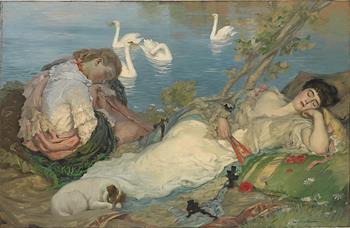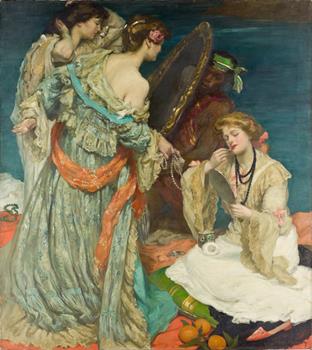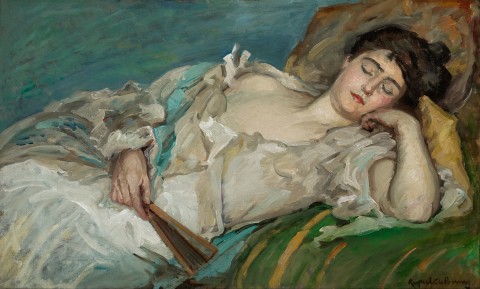STUDY FOR ENDORMIES, c.1904
RUPERT BUNNY
oil on canvas
46.0 x 76.5 cm
signed lower right: Rupert C w Bunny
Private collection
Whitford and Hughes, London
John Schaeffer, Sydney
Deutscher~Menzies, Melbourne, 10 August 1998, lot 83 (as ‘Asleep’)
Joseph Brown Gallery, Melbourne, acquired from the above
The Cbus Collection of Australian Art, Melbourne, acquired from the above on 10 September 1998
Figurative Works from the Cbus Collection, Latrobe Regional Gallery, Victoria, 4 August – 2 December 2012
Colour and Movement, Benalla Art Gallery, Victoria, 19 February – 9 June 2016
on long term loan to Bendigo Art Gallery, Victoria
Nainby, B., Stanhope, Z., and Furlonger, K., The Cbus Collection of Australian Art, in association with Latrobe Regional Gallery, Melbourne, 2009, pp. 18, 33 (illus.) 214
Thomas, D., The Life and Art of Rupert Bunny, A Catalogue Raisonné in Two Volumes, Thames & Hudson, Melbourne, 2017, volume 1: p. 16, volume 2: cat. O216, p. 35 (as ‘Asleep’)
Endormies, oil on canvas, 130.6 x 200.5 cm, in the collection of the National Gallery of Victoria, Melbourne
We are grateful to Brenda Martin Thomas, wife of the late David Thomas AM, for kindly allowing us to reproduce David's research and writing in this catalogue entry.
At the turn of the twentieth century, celebrated expatriate artist Rupert Bunny notably shifted focus from the biblical and mythological subjects which had established his reputation, towards portraiture, landscapes and images of elegant women at leisure. An exquisite, engaging example of this latter genre, Study for Endormies, c.1904 features the artist’s wife Jeanne resting, fan in hand and wearing a soft, flowing gown. Significantly, the work was conceived in preparation for one of the artist’s most universally acclaimed and admired works, Endormies, c.1904, in the collection of the National Gallery of Victoria. Featuring the same figure located in an idyllic lakeside scene, in the company of a female friend and surrounded by swans and flowers, the masterpiece is a vision of beauty and sensuality.
220245 FINAL RupertBUNNY-Endormies-Dd103215.jpg

One of Bunny’s most beautiful and accomplished works, Endormies was painted at the height of his career. It was subsequently purchased in 1911 for 500 guineas through the Felton Bequest from the artist’s exhibition at the Athenaeum Gallery, Melbourne – an exhibition described by William Moore as ‘the best one-man show of figure paintings that has been held in Australia.’1 Earlier in 1904, Bunny had exhibited Endormies at the London Royal Academy, and in 1905 his Aprés le bain, c.1904 was shown at the Salon d’Automne, Paris – from where it and another of his paintings were purchased for the Jeu de Paume, Musée du Luxembourg, Paris (now the Musée d’Orsay), making Bunny the first Australian artist to have works acquired by the French government. Indeed, reviewing the 1905 Salon exhibition art critic Arsène Alexandre from Le Figaro observed, ‘It is an exhibition of Australian painter Rupert Bunny whose art the Parisian public has been applauding for a long time. But never before has this magnificent artist manifested himself in masterpieces so outstanding in terms of colour, drawing, composition, significance and imagination…’2
Not surprisingly, Endormies attracted much critical acclaim. Henri Fritz, writing on the 1905 exhibition at the New Salon, referred to Bunny’s two portraits of women, ‘…But I
220245 Peintures_RF 1980 78.jpg

prefer another picture by this gifted artist (whose art relates itself, in my mind, to that of the fine Venetian painters), entitled Fallen Asleep [Endormies]: two beautiful women lying by a pool that glitters beneath the full glory of spring, while on it some swans are displaying their graceful forms.’3 One of these two beautiful women was of course the artist’s wife Jeanne, who was his favourite model and appeared in many of his paintings both before and following their marriage in 1902. Jeanne Heloise Morel was born in Paris in 1871 and was a fellow student with Bunny in the art classes of Jean-Paul Laurens. ‘Madame Bunny is French, and is adorable’, wrote one Australian journalist, ‘She is the soul of Rupert Bunny’s art.’4 In his many portraits of her, she appears as extremely elegant, of medium height, with lustrous black hair and a slight retroussé nose. Violet eyes added to her ravishing beauty, Bunny himself described her as having ‘the most beautiful mouth I have ever seen!’5 All this, as well as her delicately-coloured complexion may be admired in Endormies and its attendant study on offer here, which show Jeanne Bunny in the fullness of perfection. In the present work, which is followed very closely in the final version, there is the same lyrical use of colour and sensuous modelling, although arguably the play of light and handling of the paint here is more vivacious – thus imbuing the scene with a greater feeling of immediacy and intimacy.
1. Moore, W., ‘A Painter of Beautiful Women. The Remarkable Record of Rupert Bunny’, Life, 1 September 1911, p. 250
2. Arsène Alexandre, ‘Le Salon d’Automne’, Le Figaro, 17 Dec 1905
3. Fritz, H., ‘Salon of the Société Nationale des Beaux-Arts’, Studio, vol. 85, 1905, p. 122
4. Vandorian, ‘A Visit to Rupert Bunny’, Home, vol. 3, no. 4, 1 December 1922, p. 30.
5. Reddin, C., Rupert Bunny Himself: His Final Years, self-published, Melbourne, 1987, p. 154
